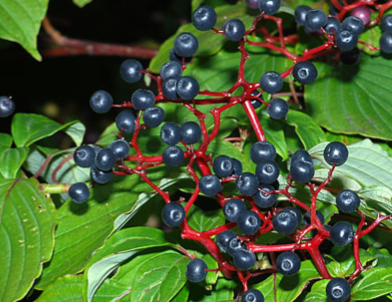- 2024 Native Trees
- >
- Native Trees
- >
- Alternateleaf Dogwood (Cornus alternifolia)
Alternateleaf Dogwood (Cornus alternifolia)
Height: 15 to 25 feet
Spread: 15 to 25 feet
Sun: Part shade
Flower: Yellowish White, Fragrant
Bloom Time: May to Early June
Suggested: Naturalized Areas, Borders, Wildlife
Native to: Jefferson County
An overlooked and underappreciated beauty of the understory, the Alternateleaf Dogwood should be introduced to the landscape.
The common name obviously derives from the nontraditional growth habit which sees the leaves and branches growing in a whorled fashion versus the traditional opposite branching of the other dogwoods. However, the whorled appearance is a stunning textural contrast to the landscape understory and provides interest for a longer duration than its cousin the Flowering Dogwood (Cornus florida) which is pushed and planted in greater frequency.
The branching grows parallel to the ground and are appear to be tiered creating a magnificent and eye catching layering effect. The layered look gives it the appearance of a pagoda, which is an alternative name for the species—Pagoda Dogwood.
Flowers appear in late May and early June and persist for over a week. The flowers are flattish in appearance and provide a great source of food for bees. When in full bloom the tree is a visionary masterpiece of layered white texture within the landscape.
Fruit is purple to red in color and are born on red to purple stems. Although the berries do not last long as they are devoured by birds, flying squirrels, and chipmunks, the stems provide lasting interest.
The tree is host to 111 species of moths and butterflies. In the summer and fall the tree is aflutter with birds seeking the larval food sources and berries that are easily obtained as a result of the layered branching.
First discovered in 1760, by a botanist serving in the French and Indian War, the tree was not readily cultivated until after the Revolutionary War. John Bartram advertised the tree in his 1783 catalog, but the sales of the tree greatly diminished because of the comparisons to the Flowering Dogwood. ■






